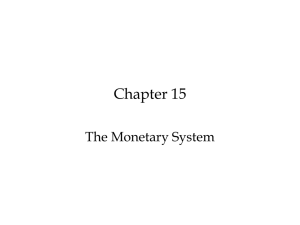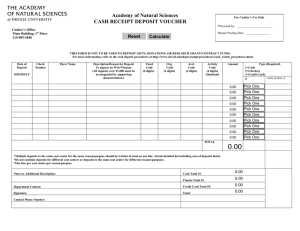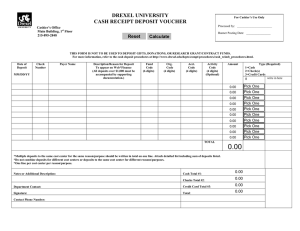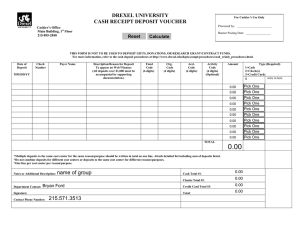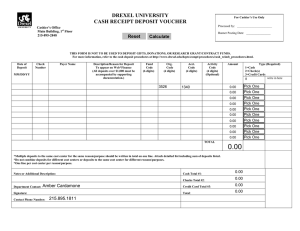O Unaddressed Concerns in the US Liquidity Rule Proposal
advertisement
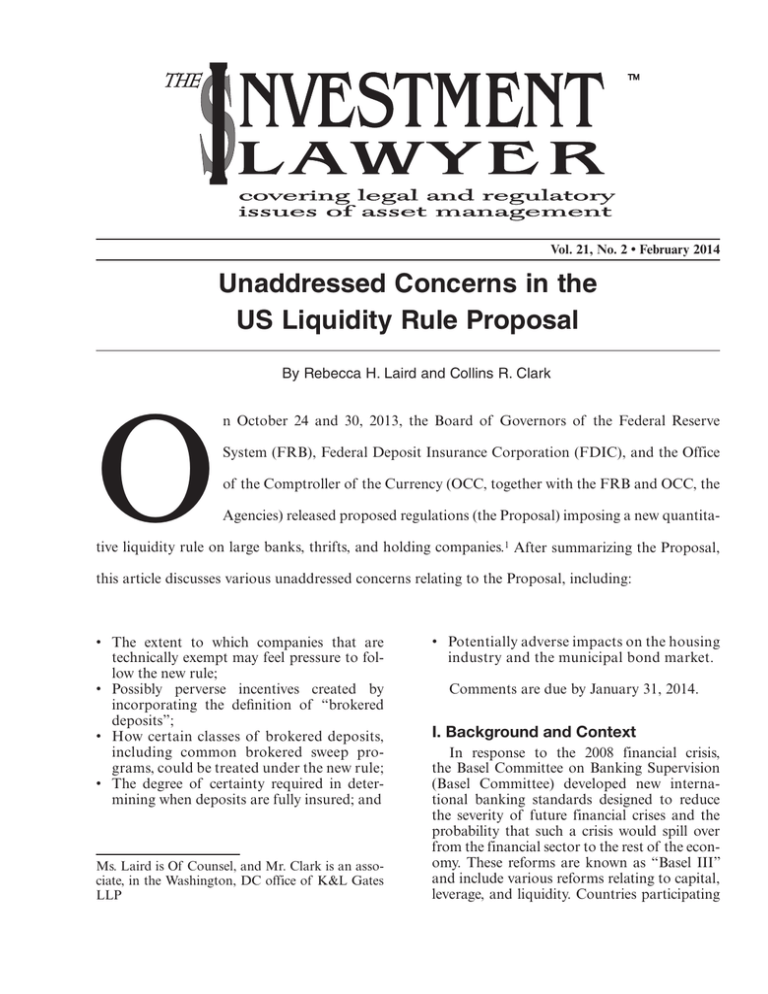
Vol. 21, No. 2 • February 2014 Unaddressed Concerns in the US Liquidity Rule Proposal By Rebecca H. Laird and Collins R. Clark O n October 24 and 30, 2013, the Board of Governors of the Federal Reserve System (FRB), Federal Deposit Insurance Corporation (FDIC), and the Office of the Comptroller of the Currency (OCC, together with the FRB and OCC, the Agencies) released proposed regulations (the Proposal) imposing a new quantita- tive liquidity rule on large banks, thrifts, and holding companies.1 After summarizing the Proposal, this article discusses various unaddressed concerns relating to the Proposal, including: • The extent to which companies that are technically exempt may feel pressure to follow the new rule; • Possibly perverse incentives created by incorporating the definition of “brokered deposits”; • How certain classes of brokered deposits, including common brokered sweep programs, could be treated under the new rule; • The degree of certainty required in determining when deposits are fully insured; and Ms. Laird is Of Counsel, and Mr. Clark is an associate, in the Washington, DC office of K&L Gates LLP • Potentially adverse impacts on the housing industry and the municipal bond market. Comments are due by January 31, 2014. I. Background and Context In response to the 2008 financial crisis, the Basel Committee on Banking Supervision (Basel Committee) developed new international banking standards designed to reduce the severity of future financial crises and the probability that such a crisis would spill over from the financial sector to the rest of the economy. These reforms are known as “Basel III” and include various reforms relating to capital, leverage, and liquidity. Countries participating in the Basel Committee approved the core Basel III reforms in December 2010, and each country is in the process of implementing the new international standards. In the US, final rules implementing the Basel III capital reforms will be phased in beginning January 1, 2014.2 The Basel III liquidity reforms call for the establishment of two new liquidity measures— the liquidity coverage ratio (LCR) and the net stable funding ratio. The LCR is designed to ensure that banks have sufficient high quality liquid resources to survive an acute stress scenario lasting one month. Once fully implemented, banks would, at all times, have to hold enough high quality liquid assets (HQLA) to cover all net cash outflows over a one-month stress scenario. The net stable funding ratio looks to a longer, one-year stress period, but is still being refined by the Basel Committee. • Insured depository institutions with $10 billion or more in assets and that are consolidated subsidiaries of a Covered Company; and • Other companies, as determined by the Agencies. The Proposal excludes the following companies, which are not Covered Companies: • SIFIs with 25 percent or more of their assets in insurance underwriting subsidiaries;3 and • Grandfathered unitary savings and loan holding companies.4 Companies that are not Covered Companies might still need to be concerned about the application of the Modified LCR (defined below). Specifically, the Modified LCR will apply to bank holding companies and savings and loan holding companies with $50 billion or more in assets. Insurance companies and grandfathered unitary savings and loan holding companies are not exempted from the Modified LCR. II. Summary of the Proposal The Proposal would require all Covered Companies (defined below) to calculate their LCR on a daily basis. The LCR would be calculated by determining the projected amount of a Covered Company’s HQLA and dividing that figure by the Covered Company’s projected “total net cash outflow amount.” A Covered Company would have to maintain an LCR of at least 80 percent in 2015, 90 percent in 2016, and 100 percent in 2017 and thereafter. Notably, this transition period is shorter and more aggressive than the Basel III transition period, which starts at 60 percent and does not reach 100 percent until 2019. B. High Quality Liquid Assets (HQLA) HQLA are assets the Agencies believe have a high potential to generate liquidity during a crisis through sale or secured borrowing. These assets would be easily and immediately convertible into cash with little or no loss of value during a period of liquidity stress. They must be unencumbered and actively traded on a secondary market in high volumes. The chart below summarizes which assets are proposed to qualify as HQLA. The chart also shows the discount Covered Companies are proposed to apply to certain HQLA and the limits on certain types of HQLA, including securities backed by a government-sponsored enterprise (GSE). In addition to the disfavored treatment of GSE-backed securities, an interesting aspect of what qualifies as a HQLA relates to what the Proposal excludes. All instruments issued by a financial company, including insurance companies, investment companies, investment advisers, hedge funds, pension funds, and their subsidiaries, would be excluded. The Agencies note that during periods of stress financial company instruments lose value and are less A. Covered Companies As proposed, the LCR will apply to the following “Covered Companies:” • Insured depository institutions, bank holding companies, savings and loan holding companies, and systemically important financial institutions (SIFIs) with: ❍ ❍ $250 billion or more in assets; or $10 billion or more in on-balance sheet foreign exposure; THE INVESTMENT LAWYER 2 CATEGORIES OF HIGH QUALITY LIQUID ASSETS CALCULATION Level 1 Reserves held at a Federal Reserve Bank (excluding required reserves under Fair value under GAAP Regulation D and certain term deposits) Withdrawable reserves held at a foreign central bank and not subject to any use restriction US government securities, fully and explicitly guaranteed Securities backed by certain foreign sovereigns, central banks, or international organizations Foreign sovereign securities held to meet cash outflow needs in that jurisdiction Level 2A Securities backed by a US GSE 15 percent haircut applied to GAAP fair value Certain securities backed by foreign sovereigns or international organizations and not included in Level 1 Together with Level 2B, capped at 40 percent of HQLA Level 2B Publicly traded corporate debt securities that lost no more than 20 percent of their value in any 30-day period and are not obligations of financial companies 50 percent haircut applied to GAAP fair value Equities of companies in the S&P 500 or a similar index that lost no more than 40 percent of their value in any 30-day period and are not issued by financial companies Capped at 15 percent of HQLA Companies would need to apply in determining which liabilities will have to be paid out during the next 30 days. Although Basel III calls for term deposits with a residual maturity of greater than 30 days to be “excluded from total expected cash outflows,”5 the Proposal applies assumed runoff rates to certificates of deposit and other term deposits that do not mature within 30 days. A summary of the assumed outflow categories is included as an Appendix to this article, but we note that the definitions and rule text are nuanced and would be consulted when determining what assumed runoff rate applies to a particular funding source if the Proposal is adopted. Covered Companies would have to use the highest outflow amount on any given day for their calculations. Covered Companies also would have to assume that any options for outflow would be exercised at the earliest possible day, ignoring any notice period, and liquid, in contrast to instruments issued by nonfinancial companies. Securities and covered bonds issued or backed by states and municipalities and assets designated to cover operational costs are also proposed to be excluded. Covered Companies would need to develop policies and procedures to monitor and manage their HQLA, identifying HQLA and determining their adequacy on a daily basis. Policies and procedures would also need to account for repatriation concerns because the Proposal requires that sufficient HQLA be held in the US to cover all US needs. C. Net Cash Outflow A Covered Company would have to calculate its projected total net cash outflow amount as of a predetermined time each day over a 30-day horizon. The Proposal includes a detailed listing of assumptions Covered 3 Vol. 21, No. 2 • February 2014 By assigning individual assumed outflow rates to various funding sources, the Agencies might be revealing their view of the reliability of different funding sources. Those views could influence the Agencies’ expectations of how exempt institutions (non-Covered Companies) manage liquidity risk. Some exempt institutions could feel pressure to consider the LCR and other elements of the Proposal in their individual liquidity risk management plans.6 The extent to which this occurs, even if unintentionally, will depend on the actions of the Agency examiners. In addition, the practical impact of the Modified LCR may be to indirectly require the depository institution subsidiary to follow the Modified LCR. Especially in holding company structures where other subsidiaries are relatively small, the burden of complying with the Modified LCR may fall primarily on the depository institution. In those circumstances, the policy reasons for not applying the Modified LCR to depository institutions would seem to be undermined to some extent. that all options for inflow would be exercised at the latest possible day, counting any notice periods. In the net cash outflow calculation, outflow would be offset somewhat by expected inflow from contracts or interest payments. But, only half of the projected inflow from retail customers or from wholesale funding by non-financial companies would count for purposes of the LCR, and the total recognized inflow amount would be capped at 75 percent of outflow. No matter how high the projected inflow is, a Covered Company will always have a net outflow for purposes of the LCR. D. Enforcement If a Covered Company’s LCR falls short on any single day, the Covered Company must notify its regulator. If the LCR is inadequate for any three days, the Covered Company must file a remediation plan with its regulator. E. Modified LCR Acting on its own, the FRB proposed a “Modified LCR” applicable to bank holding companies and savings and loan holding companies with $50 billion or more in assets. The Modified LCR is less stringent than the LCR in that it: (i) is calculated over a 21-day horizon, not 30 days; (ii) includes assumed outflow rates that are reduced by 70 percent (see the Appendix for the rates); and (iii) does not require using the peak outflow day during the period as the base for all calculations. The Modified LCR is not part of Basel III, and it would not be applied at the depository institution level. As explained below, the fact that depository institutions are exempt from the Modified LCR does not mean that depository institutions might not feel indirect pressure to follow it. B. The Proposal’s treatment of brokered deposits imports flaws inherent to the definition of “deposit broker” and fails to fully consider certain realities of the deposit markets. Basel III does not address the concept of “brokered deposits,” but the Proposal uses that term and incorporates an existing definition of “deposit broker” from the Federal Deposit Insurance Act.7 By doing so, the Agencies also import a body of administrative guidance interpreting that term. The breadth of the “deposit broker” definition is problematic and applying it in the context of the LCR might create several difficulties that the Proposal does not address. First, it might create perverse incentives. For example, deposits raised online through a listing service are not brokered deposits under current interpretations and might be retail deposits under the Proposal, meriting a favorable assumed outflow rate of 10 percent. If the online deposit is a transaction account or if the depositor has a second account at the same institution, it might be given an even more favorable assumed outflow III. Unaddressed Concerns A. To what extent will depository institutions and holding companies that are not Covered Companies be expected to follow the LCR or the Modified LCR? THE INVESTMENT LAWYER 4 by affinity groups, affiliates, or third party marketers. Fourth, the Proposal does not appear to contemplate contractual requirements that are common in many brokered sweep programs. In these programs, brokers generally commit to maintain an aggregate deposit balance over a period of time. As with a time deposit, significant penalties apply if the broker reduces the balance below that minimum amount. Because the Proposal refers to brokered deposits that “mature” within 30 days, it could be argued that brokered sweep deposits that are subject to a contractual period would not “mature” within 30 days and would be entitled to a more favorable runoff rate than would otherwise apply. It is not clear what the Agencies intend. Fifth, the assumed outflow of a brokered sweep deposit appears to depend on whether the deposit is fully insured, but depository institutions participating in sweep programs are not able to determine with certainty whether a deposit is fully insured. In sweep programs, brokers monitor account balances to ensure that the balance of each customer’s funds in the sweep program does not exceed the deposit insurance limit, but brokers depend on customers to tell them if they have other funds with a particular institution outside of the sweep program. If a customer fails to notify the broker, the customer’s total deposits with that institution could exceed the insurance limit. Similarly, depository institutions do not know the identity of the individual sweep customers so they cannot determine, with certainty, whether the insurance limit has been exceeded. This is also true for many brokered time deposits. It is not clear what degree of certainty the Agencies expect depository institutions to have when determining whether a brokered deposit is fully insured. of three percent. In contrast, if the institution pays its own employee anything other than “primarily in the form of a salary,” for example, commissions, bonuses, or perhaps even hourly wages, to bring in deposits, all deposits facilitated by that employee might be brokered deposits and disfavored under the LCR.8 Deposits referred by affiliates or a dual employee could also be brokered deposits and disfavored.9 The number of additional relationships and the nature of the deposit (that is, checking, savings, etc.) have no bearing on whether it is a brokered deposit. It is hard to believe that a deposit raised by a dual employee or an affiliate is more likely to leave than an identical deposit raised through a listing service. Second, the Proposal’s special treatment of reciprocal deposits and sweep deposits echoes the FDIC’s findings in a 2011 study that these types of brokered deposits have certain characteristics of stability, but the Proposal does not appear to account for other characteristics that the FDIC determined were “most useful” in evaluating deposit stability.10 The characteristics include relative interest rates, whether deposits are gathered quickly or in bulk, and, to a certain extent, the existence of multiple customer relationships. Concerning multiple customer relationships, the FDIC’s study notes that “deposits that are based upon a customer relationship are likely to contribute to franchise value because they are more stable and they allow the bank to acquire long-standing relationships.”11 The Proposal accounts for this in the context of determining whether a retail deposit qualifies for the most favorable runoff rate, but appears to ignore it in the context of brokered deposits. The Agencies do not offer any explanation for why an additional relationship is relevant to a retail deposit, but not a brokered deposit. Third, the categories of assumed outflow do not appear to account for all types of brokered deposits. The Proposal has categories for brokered deposits that “mature” (presumably time deposits), brokered sweep deposits, and brokered reciprocal deposits, but there is no category for other retail brokered deposits. Other types of brokered deposits include brokered checking accounts, brokered savings accounts, and deposits referred C. How will the Proposal impact the housing industry? To some extent, the Proposal appears to discourage Covered Companies from investing in the housing industry. GSE-backed securities would be subject to a 15 percent haircut when counting as HQLA, and any expected inflow from mortgage commitments within the next 30 days will be excluded from the net outflow 5 Vol. 21, No. 2 • February 2014 bond markets by excluding from the definition of HQLA securities and covered bonds issued or backed by states and municipalities. With fewer benefits for the largest institutions to participate in the market, it is unclear whether smaller institutions will make up the difference in providing support to the state and municipal bond markets. calculation. It is unclear what impact this would ultimately have on mortgage markets. D. How will the Proposal impact the municipal bond market? The Proposal also discourages Covered Companies from participating in the municipal Appendix Proposed Liquidity Rule Outflow Assumptions ASSUMED OUTFLOW FUNDING TYPE LCR MODIFIED LCR DEFINITION AND COMMENTS Stable Retail Deposits 3 percent 2.1 percent Meets “retail deposit” definition below; Fully insured; and Either (i) transaction account; or (ii) one of multiple account relationships. Other Retail Deposits 10 percent 7 percent From individuals or qualifying small businesses. Excludes all “brokered deposits.” Other Retail Funding 100 percent 70 percent From individuals or qualifying small businesses; and Does not meet the “retail deposit” or “stable retail deposit” definitions above. Reciprocal Brokered Deposits 10 percent (fully insured) 25 percent (part insured) 7 percent (fully insured) 17.5 percent (part insured) Placed through a network where one bank places deposits in another bank equal to the amount received; and Each bank sets the interest paid on the entire amount it placed in the network. From individuals or qualifying small businesses. Fully Insured, Affiliate Brokered Sweep Deposits 10 percent 7 percent Retail customer must have a contract with: (i) the bank; (ii) a bank subsidiary; or (iii) a bank affiliate. From individuals or qualifying small businesses. Brokered Sweep Deposits 25 percent (fully insured) 40 percent (part insured) 17.5 percent (fully insured) 28 percent (part insured) Funds at a regulated financial company are automatically transferred (swept) to a bank each day. From individuals or qualifying small businesses. 10 percent (after 21 days) 100 percent (within 21 days) From individuals or qualifying small businesses. Brokered Deposits that 10 percent Mature (after 30 days) 100 percent (within 30 days) THE INVESTMENT LAWYER 6 ASSUMED OUTFLOW FUNDING TYPE LCR MODIFIED LCR DEFINITION AND COMMENTS Fully Insured Operational Deposits 5 percent 3.5 percent Required in connection with the provision of operational services (e.g., payment remittance, payroll administration, reconciliation of payment orders, settling securities transactions, daylight overdraft) as a third party intermediary. Excludes all escrow accounts. 14 percent Unsecured wholesale funding not provided by a regulated financial company. Excludes brokered deposits and operational deposits. Non-Financial, Fully 20 percent Insured, Non-Brokered Wholesale Funding Escrow Accounts and Partially Insured Operational Deposits 25 percent 17.5 percent Required to provide operational services as a third party intermediary. Non-Financial, Partially Insured or Brokered Wholesale Funding 40 percent 28 percent Unsecured wholesale funding not provided by a regulated financial company that is either: (i) partially insured; or (ii) a brokered deposit. Excludes operational deposits. Other Wholesale Funding 100 percent 70 percent Unsecured wholesale funding not covered by one of the wholesale funding or operational deposits categories above. 0 percent 0 percent Banks must be affiliates and subject to the LCR. • Retail Counterparties 5 percent 3.5 percent Commitments to individuals or qualifying small businesses. • Non-Financial Wholesale Counterparties 10 percent (credit facility) 30 percent (liquidity facility) 7 percent (credit facility) 21 percent (liquidity facility) Wholesale counterparties that are not banks, bank holding companies, investment advisers, investment companies, pension funds, hedge funds, or their subsidiaries. • Banks and Bank Holding Companies 50 percent 35 percent Excludes affiliated banks subject to the LCR. • Financial Wholesale Counterparties 40 percent (credit facility) 100 percent (liquidity facility) 28 percent (credit facility) 70 percent (liquidity facility) Wholesale counterparties that are investment advisers, investment companies, pension funds, hedge funds, or their subsidiaries. Excludes banks and their holding companies. • Special Purpose Entities 100 percent 70 percent Excludes liquidity facilities extended to affiliated special purpose entities. • Other Counterparties 100 percent 70 percent Credit and Liquidity Facility Commitments To: • Affiliated Banks 7 Vol. 21, No. 2 • February 2014 ASSUMED OUTFLOW FUNDING TYPE LCR MODIFIED LCR Structured Transactions Greater of: (i) 100 percent of debt obligations maturing within 30 days; or (ii) maximum amount payable through a funding agreement. Greater of: Repayment largely from cash flow (i) 100 percent of generated by the assets securing the debt obligations obligation. maturing within 21 days; or (ii) maximum amount payable through a funding agreement. Net Derivative Cash Outflow Payments to make, less payments to receive, within 30 days. Payments to make, less payments to receive, within 21 days. Excludes all “mortgage commitments” as defined below. Mortgage Commitments 10 percent of what can be drawn within 30 days 10 percent of what can be drawn within 21 days Contractual commitments for origination of retail mortgages. Unstructured Debt Securities 3 percent of those maturing in more than 30 days 3 percent of those maturing in more than 21 days The Covered Company is the primary market maker Structured Debt Securities 5 percent of those maturing in more than 30 days 5 percent of those maturing in more than 21 days The Covered Company is the primary market maker Secured Funding, Asset Exchange, Substitute Collateral 0 to 100 percent 70 percent of amount under LCR Treatment depends on the quality of the collateral. Foreign Central Bank Borrowing Outflow assigned 70 percent of by the foreign amount under jurisdiction LCR Other Contracts 100 percent 70 percent Notes Other amounts payable under other legally binding agreements. 4. The FRB Staff memorandum released in connection with the Proposal suggests that after grandfathered unitary savings and loan holding companies are required to establish intermediate holding companies, the intermediate company would likely be subject to the LCR. 1. 78 Fed. Reg. 71818 (Nov. 29, 2013). 2. 78 Fed. Reg. 62018 (Oct. 11, 2013) (FRB and OCC); 78 Fed. Reg. 55340 (Sept. 10, 2013) (FDIC). 3. Of the designated SIFIs, AIG and Prudential are insurance companies and are, therefore, not Covered Companies. The other designated SIFI, GE Capital, is a grandfathered unitary savings and loan holding company. THE INVESTMENT LAWYER DEFINITION AND COMMENTS 5. Basel Committee, Basel III: The Liquidity Coverage Ratio and liquidity risk monitoring tools ¶ 82 (Jan. 2013). 6. See Interagency Policy Statement on Funding and Liquidity Risk Management (Mar. 3, 2010) (75 Fed. Reg. 8 13656 (Mar. 22, 2010)) (establishing expectations for how institutions manage funding and liquidity risk). definition of “retail deposit” expressly excludes all brokered deposits. 7. 12 U.S.C. § 1831f(g). 9. See 12 U.S.C. § 1831f(g)(4)(A). 8. See 12 U.S.C. § 1831f(g)(4)(B); FDIC Advisory Opinion 93-50 (Jul. 27, 1993), available at http://www.fdic. gov/regulations/laws/rules/4000-8390.html; FDIC Advisory Opinion 92-75 (Nov. 3, 1992), available at http://www.fdic. gov/regulations/laws/rules/4000-7660.html. The proposed 10. See FDIC, Study on Core Deposits and Brokered Deposits 49 (Jul. 8, 2011), available at http://www.fdic.gov/ regulations/reform/coredeposits.html. 11. Id. at 51. Copyright © 2014 CCH Incorporated. All Rights Reserved Reprinted from The Investment Lawyer February 2014, Volume 21, Number 2, pages 19–26, with permission from Aspen Publishers, Wolters Kluwer Law & Business, New York, NY, 1-800-638-8437, www.aspenpublishers.com

